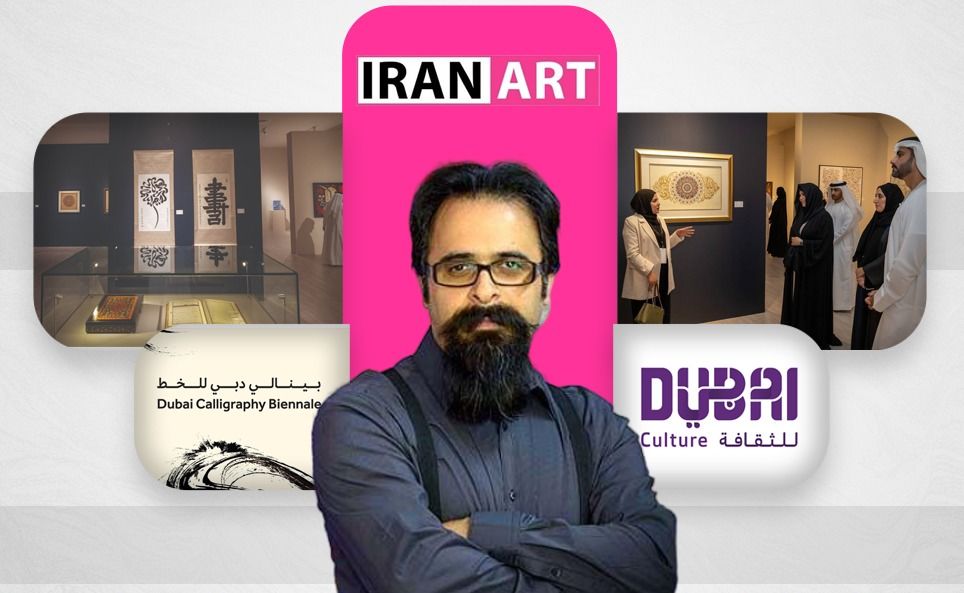Five Highlights of the First Dubai Calligraphy Biennale According to Hossein Hashempoor

The Dubai Biennale is now a dialogue scene of calligraphy in all eight official languages of the world thanks to calligraphy.
Iranart: Hossein Hashempoor: 1: The first Dubai Calligraphy Biennale offers an expansive international view of calligraphy in 8 different languages; an innovative and forward-thinking interaction.
The first edition of the event managed to align with the Dubai Culture Manifesto, which reflects the macro policy of the UAE. Part of Dubai Culture's statement is as follows:
"Dubai Culture supports and inspires local and international creative talent, ensuring that art and creativity can be practiced and enjoyed by anyone, anywhere. It empowers the growth of Dubai’s creative sector as a key contributor to the emirate’s economic growth and position on the global cultural map."
2: For the Middle East, calligraphy has a distinct significance and character. Calligraphy emerged in the Middle East, despite the fact that the types of modernist art on which the region's artists base their work had their roots in the West. The Dubai Calligraphy Biennale places a lot of attention on this historical truth and serves as a reminder of it.
3: The Dubai Biennale is now a dialogue scene of calligraphy in all eight official languages of the world thanks to calligraphy. These days, an appropriate area has been offered for the researchers of this thousand-pattern art in Dubai, ranging from Arabic Thuluth, Kufi, and Calligraphy to Iranian Nastaliq and Broken, Turkish Naskh and Thuluth, Japanese Manga, and other writing systems of the Far East.
Dubai Culture emphasized this horizon in another section of its manifesto:
"The key strategic pillars underpin the Authority’s mandated role as a policymaker and planner, regulator, enabler and operator – one that seeks to facilitate and promote the development and sustainability of the city’s cultural ecosystem and creative economy."
4: Many people have moved away from this old art in recent years due to a strategic error that occurred in the presentation and display of calligraphy in international galleries. The general population has the idea that writing system is no longer visually appealing. However, the Dubai Calligraphy Biennale at the DIFC, along with Al Safa Art, Kalimat Gallery, and several other locations, performance-like shows, reflections with dance of light, as well as reflections of calligraphy on clothing, decorative items, and ornaments, show calligraphy as a fascinating and practical art that also happens to be very modern.
Through 16 shows and a variety of tactics in 30 public venues, including shopping malls like City Centre Mirdif, the Dubai Calligraphy Biennale has introduced calligraphy to people all around Dubai. Along with Dubai residents, thousands of tourists have gathered with calligraphy outside of galleries and in the open spaces of urban areas.
5: One of the most obvious benefits of the event for the Middle East is the involvement of two business sponsors as supporters of the first Dubai Calligraphy Biennale. Although Dubai Culture had the initiative to start the show, the government agency did invite two corporate and economic groups to assist this artistic endeavor.
Large commercial, economic, and artistic holdings are often juxtaposed today in the West, as well as in China, Hong Kong, and South Korea, but this unavoidable necessity has not yet occurred in the vast majority of Middle Eastern nations.
Al Rostamani Group, the primary sponsor, and Sandooq Al Watan, a secondary sponsor, support the Biennale so that Dubai can once again demonstrate its commitment to clarifying universal themes.
Art must be connected with the private sector for overall development, creation of a sustainable art market, and art economy, and Dubai Culture has correctly made this point.

